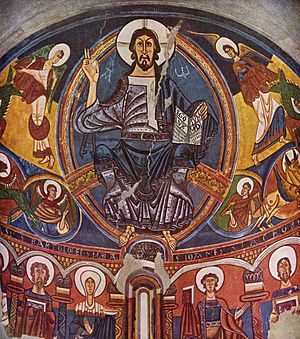Master of Taüll facts for kids

The Master of Taüll was a very important artist from the 1100s. He is known as one of the best mural painters of his time in a region called Catalonia in Spain. He was also one of the most famous Romanesque painters in all of Europe.
Contents
Who Was the Master of Taüll?
The Master of Taüll was not just any painter. He was a master of creating large paintings directly onto church walls and ceilings. This type of art is called a mural. His style is known as Romanesque, which was popular in Europe during the Middle Ages. Romanesque art often featured strong lines, bright colors, and religious scenes.
Amazing Art in Churches
The Master of Taüll's most famous work is found in the church of Sant Climent de Taüll. This church is in a beautiful valley in the Pyrenees mountains of Spain.
The Famous Taüll Paintings
The most well-known painting from Sant Climent de Taüll is a huge artwork from the church's apse. An apse is the rounded part at the end of a church. This amazing painting shows Pantocrator, which means "Christ in Majesty." It is now kept safe in the Museu Nacional d'Art de Catalunya in Barcelona, Spain. People from all over the world visit the museum to see it.
Other Works: From Spain to America
The Master of Taüll also painted in another church called San Baudelio de Berlanga in Castile, Spain. Most of these paintings have also been moved to protect them. Many of the larger paintings, especially those showing stories from the New Testament, are now in museums in the United States.
For example, two large sections showing "The Entry of Christ into Jerusalem" and "The Wedding at Cana" are at the Indianapolis Museum of Art. Other parts, like "The Healing of the Blind Man and the Raising of Lazarus" and "The Temptation of Christ," can be seen at The Cloisters (part of the Metropolitan Museum of Art) in New York. Some pieces are also in the Prado museum in Madrid, Spain.
What Made His Art Special?
The scenes from the "Life of Christ" that the Master of Taüll painted were quite unusual for Spanish art at that time. Besides these religious stories, he also painted everyday scenes. These included pictures of hunting and falconry, which is hunting with trained birds. He even copied patterns from beautiful fabrics onto the walls.
Some of his frescoes also show interesting animals like a camel and a war elephant. These animals were not common in Spain and were likely inspired by art from Muslim cultures. This shows how different cultures could influence artists even centuries ago.
See also
 In Spanish: Maestro de Tahull para niños
In Spanish: Maestro de Tahull para niños

